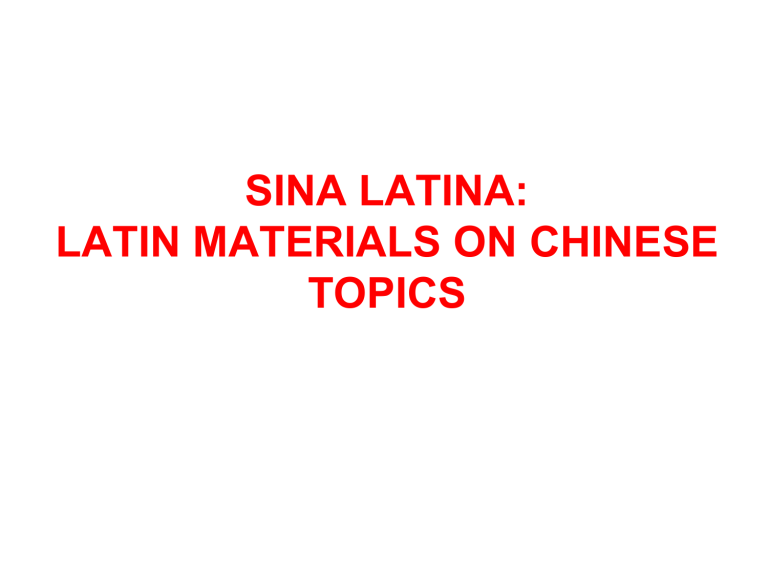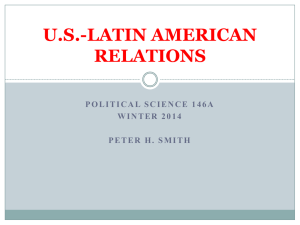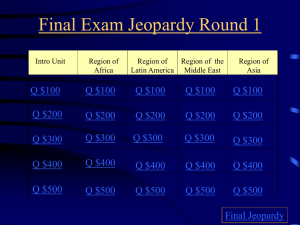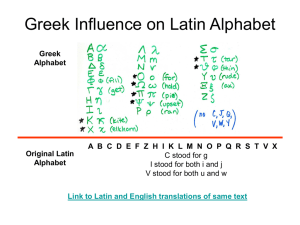File

SINA LATINA:
LATIN MATERIALS ON CHINESE
TOPICS
LATIN NAMES FOR CHINA AND
THE CHINESE
• S ēres, -um: In use from at least 1st cent. B.C, Greek loan word probably deriving ultimately from
絲 (Latin for silk is s ē ricum, ī n), so means `the silk people’; the adjectival form Sērica (sc. terra) could be used to refer specifically to the land. But classical writers seem to have used
S ēres also to refer to other peoples along the
`Silk Road’ or even in other regions.
• Sīnae, ārum: Referred to both people and place, via Greek
Sīnai
or
Thīnai
from Sanskrit
Cīna
or a common source that may have been the dynastic names Qin (秦) or Jing (荆), or
ʐina ,
the indigenous name for the Yelang夜郎 polity in Yunnan, through which Chinese products often reached India. Ptolemy (c.150 A.D.) distinguishes
Sīnai
in southern China from the more northerly
Sērica
but by the
Middle Ages Sīnae was standard usage for China as a whole, with the singular Sīna used less often. Early modern texts sometimes used China (e.g. in the title of Kircher’s 1667 Latin publication
China
Illustrata
) but this is not found in recent Latin writing.
A passage in the Book of Han ( 漢書 ) refers to soldiers in the army of a Xiongnu (Hun?) chieftain adopting a
`fishscale’ formation when defending their fortress in Kazakhstan against a Han attack in 36 B.C. It has been suggested this was the Roman t estūdō tactic and that the soldiers were amongst Roman prisoners captured after their defeat by the Parthians at Carrhae (in modern Turkey) in 53 B.C. and sent to defend
Parthia’s eastern frontier in present-day Turkmenistan. These men were supposedly later taken into
Chinese service and founded the village of Liqian (< legi ō?) in Gansu, However, although a number of villagers now appear to have Caucasian ancestry this could easily be simply the result of ethnic intermarriage along the Silk Road
Eastern trade as described in `The Periplus of the Erythraean Sea’, a
Greek text compiled in the 1st century A.D. Chapter 64 states: `Under the very north ( i,e north from the Malay Peninsula ), the sea outside ending in a land called Thys, there is a very large inland city called Thinae, from which raw silk yarn and silk cloth are brought on foot through Bactria to
Barigaza ( Bharuch in Gujarat ).’
THE WORLD ACCORDING TO POMPONIUS
MELA (43 A.D.?)
Latin text at http://www.hs-augsburg.de/~harsch/Chronologia/Lspost01/Pomponius/pom_orbi.html
• Eurasia and Africa completely surrounded by sea but
Asia and Africa imagined much smaller than in reality.
• A hypothetical continent south of the equator but assumed to be inaccessible because of the unbearably hot zone separating it from Africa.
• The Caspian Sea as a gulf connected to the Arctic
Ocean.
• The `Seres’ in the middle of Asia’s eastern coast.
•
"In the ninth Yongyuan year (97 A.D.) during the reign of Emperor He, Protector General Ban
Chao sent Gan Ying ( 甘英 ) to Da Qin ( 大秦 , the Roman Empire). He reached Tiaozhi (probably the kingdom of Characene, whose capital was Charax Spasinou ) and Sibin (?
Susiana , western
Persia) next to a large sea. He wanted to cross it, but the sailors of the western frontier of Anxi
[Parthia] said to him:
`The ocean is huge. Those making the round trip can do it in three months if the winds are favourable. However, if you encounter winds that delay you, it can take two years.
That is why all the men who go by sea take stores for three years. The vast ocean urges men to think of their country, and get homesick, and some of them die.’
When [Gan] Ying heard this, he discontinued (his trip).”
Tashkurgan (`Stone Fortress’) in Xinjiang, the furthest point east on the Silk Road reached by the
Macedonian Maes Titianus, who probably made his journey in the late 1st century or early 2nd century
A.D. The Seleucid Empire (one of the Hellenistic successor kingdoms to Alexander the Great’s empire) had already been brought to an end by the Romans in 64 B.C.
The inhabited world as known to the Greek geographer Ptolemy (c. 90 –
168 A.D.) and engraved by Johannes Schnitzer in 1482
SouthEast Asia as drawn in the 15th century from Ptolemy’s coordinates. ` Sinae ’ is clearly shown north of the Gulf of Tonkin, with
` Sericae pars ’ (`part of Serica’) further north
The Hou Han Shu records the arrival in 166 A.D. (about 15 years after the publication of Ptolemy’s maps) of an embassy from 安敦 (i.e. Antonius), king of
Da Qin (i.e. Rome). The ambassadors travelled by sea, probably entering
China through Tonkin and must have been sent either by Antonius Pius (died
161) or his successor, Marcus Aurelius Antonius.
The route of Johannes de Plano Carpini, one of several friars sent by Pope Innnocent III as envoys to the Mongol court. The Latin text of his report on his 1245-47 journey is available at http://ebooks.adelaide.edu.au/h/hakluyt/voyages/carpini/latin.html#section2
The route of the mission to the Tartar (Mongol) kingdom undertaken by the Franciscan friar William of Rubruck (Willielmus de Rubruquis) in 1253-54 on the orders of King Louis
IX of France. His Latin account of his travels predates Marco Polo’s Italian memoirs and is a more sober and better-ordered document. Unlike Marco Polo, he took a route north of the Caspian Sea and was able to provide final confirmation that this was an inland sea, not, as many in the Middle Ages still believed, a gulf connected to the Arctic ocean. He also accurately described the essence of Chinese writing: ` faciunt in una figura plures literas comprehendentes unam dictionem ’ (`They combine in one figure several letters making up one word’)
The Nestorian Christian monk Rabban Bar Sauma, born in or near Beijing but of Turkic
(probably Uyghur) descent, lived for many years in Baghdad, as he was prevented by fighting between Arabs and Mongols from completing an intended pilgrimage to Jerusalem. In 1287, he was sent as an ambassador to Europe by the Mongol Khan Arghun, who, though nominally subordinate to the Mongol emperor in Beijing, functioned largely as independent ruler of a kingdom centred on modern Iran. Though unable to achieve the desired alliance against the
Arabs, Sauma met the pope and the kings of France and England, and left a Syriac account of his travels, available on-line in English translation ( http://www.aina.org/books/mokk/mokk.htm
)
One of the most important manuscripts of the memoirs of Marco Polo, who visited China in the late 13th century, is a Latin version found in Toledo cathedral in Spain
John of Monte Corvino, a Franciscan missionary despatched to China in 1294, established the first resident western Christian mission in Khanbaliq (Beijing), dying there in 1328. Despite opposition from the Nestorian Christian community, he enjoyed the protection of Kublai Khan’s successor, Timur, and made numerous converts. The
Christians were, however, expelled after the Ming supplanted the Mongols in 1369.
Ordoric, a Franciscan monk born in Italy but of Czech descent, travelled extensively in India, SE Asia and China between 1318 and 1330, accompanied for ay least part of the time by an Irish companion, Brother James. His Latin memoir of his journey is reproduced in Henry Yule’s Cathay and the Way Thither and available at http://archive.org/stream/cathayandwaythi00marigoog#page/n356/mode/2up For a short account of his life, see http://en.wikipedia.org/wiki/Odoric_of_Pordenone He was alone amongst European travelers of his age in noting the widespread Chinese custom of foot-binding.
Jesuit missionary Matteo Ricci, who had originally been sent to India, entered China through
Macao in 1583 and, relying both on his own technical knowledge and his adoption of Chinese ways, went on to become in influential figure in court circles. De Christiana Expeditione apud
Sinas Suscepta , a compilation of his reports, edited by fellow-Jesuit Nicolas Trigault and published in 1617, is on-line at http://books.google.com.au/books?id=iLsWAAAAQAAJ
Emperor Kangxi (reigned 1662 – 1723 ) with the German Jesuit astronomer
Adam Schall and colleagues. A major reason for the Jesuits’ influence at the
Chinese court in the 17th century was their mastery of the latest developments in European astronomy, which had by this time surpassed both the Chinese and the Islamic traditions.
Historica Narratio , a compilation of Schall’s own reports from China, was published in 1665, and is at http://books.google.at/books?id=VqJGAAAAcAAJ .
The book is discussed in David Morgan’s essay ` Dē Adami Schall Historicā
Nārrātiōne: Quō Modō Sīnae Sint Latīnae Factae’
Kircher’s CHINA ILLUSTRATA (1667)
The highly-learned author, who also wrote on micro-biology, Egyptology and classical antiquities and has been described as `the last man who knew everything,’ had not himself visited China but drew on the reports sent back to Europe by his fellow Jesuits
In 1702 Arcade Huang ( 黃嘉略 ), a mission-educated Chinese Christian was brought to Europe by Bishop Artus de Lionne ( left ), becoming Chinese interpreter to Louis XIV and cataloguer of
Chinese works in the palace library. He is said to have drafted a Chinese-Latin dictionary and, after his premature death in 1716, his pioneering work on a grammar of Chinese was completed by Étienne Fourmont, who published it with Latin explanations in 1742.
`
Nobilis filia Ça xiao kie passa verecundiam ad vindicandum postea –
De vino cognoscitur homo quid vult intus corde, quid amat, movet passiones, potest solvere tristiam ( error for tristitiam ), delere mestitiam, sed nocet aetati, facit hominem prudentem in stultum, mutat faciem mansuetam in tyrannam, uno verbo est medicina cogens hominum ( error for hominem ) ad insaniam. Haec verba hortantur ut homines cum temperantia bibant vinum.’
Noble daughter Ça xiao kie suffered shame for the sake of later vindication (?) – From wine one knows what a man wants in his heart, what he loves, what moves his passions; it can dissolve sadness, put an end to unhappiness, but it is harmful to life, makes a sensible man into a fool, turns a gentle countenance into a tyrannical one, in a word it is a drug driving a man into insanity.
These words urge that men should drink wine in moderation
Text quoted in 1811 by French Orientalist Abel R émusat from a translation by
`Abel Y ên’ from Beijing of a Chinese short story. The translator and Arcade
Huang are mentioned by R émusat as rare examples of Chinese who showed any interest in foreign language and the lines themselves were the only example of Latin written by a Chinese at this time that could be discovered for use in this PowerPoint
German Orientalist Julius Mohl, and the title page of his
1834-39 edition of the I-Ching ( 易經 ), based on earlier work by Jesuit scholars.
Literary scholar, Christian apologist and children’s author C.S. Lewis, who conducted a correspondence in Latin over several years with an Italian priest, wrote in 1953 `d ē cl ā de ill ā
S ē ric ā’ (aka`解放’!)
David Morgan (1959 2013), enthusiastic proponent of `living Latin’, conducting a class. As well as his on-line modern Latin dictionary he wrote an article in Latin on Adam Schall’s Historica Narratio de Initio et
Progessu Missionis Societatis Iesu apud Chinenses (Vienna, 1665)
THYIADII
(Chia Tao)
Anachoretam quemdam quaerit poeta, neque tamen invenit
Pinus subter, ab assecla
Deserti dominum jure requirimus.
Is vero «procul hinc pater:
Herbas jam medicas ipse per ardua
Terrarum, atque virentia
Collecturus abit, nubibus abditus
Spissis,» inquit, «et aëre.
Quo secedat... io! me penitus latet.»
One of the translations – or expansions – of classical Chinese poetry recently produced by Italian Classicist and Sinologist Massimo
Scorsone
(see http://www3.unisi.it/semicerchio/upload/sc34_scorsone.pdf
)







